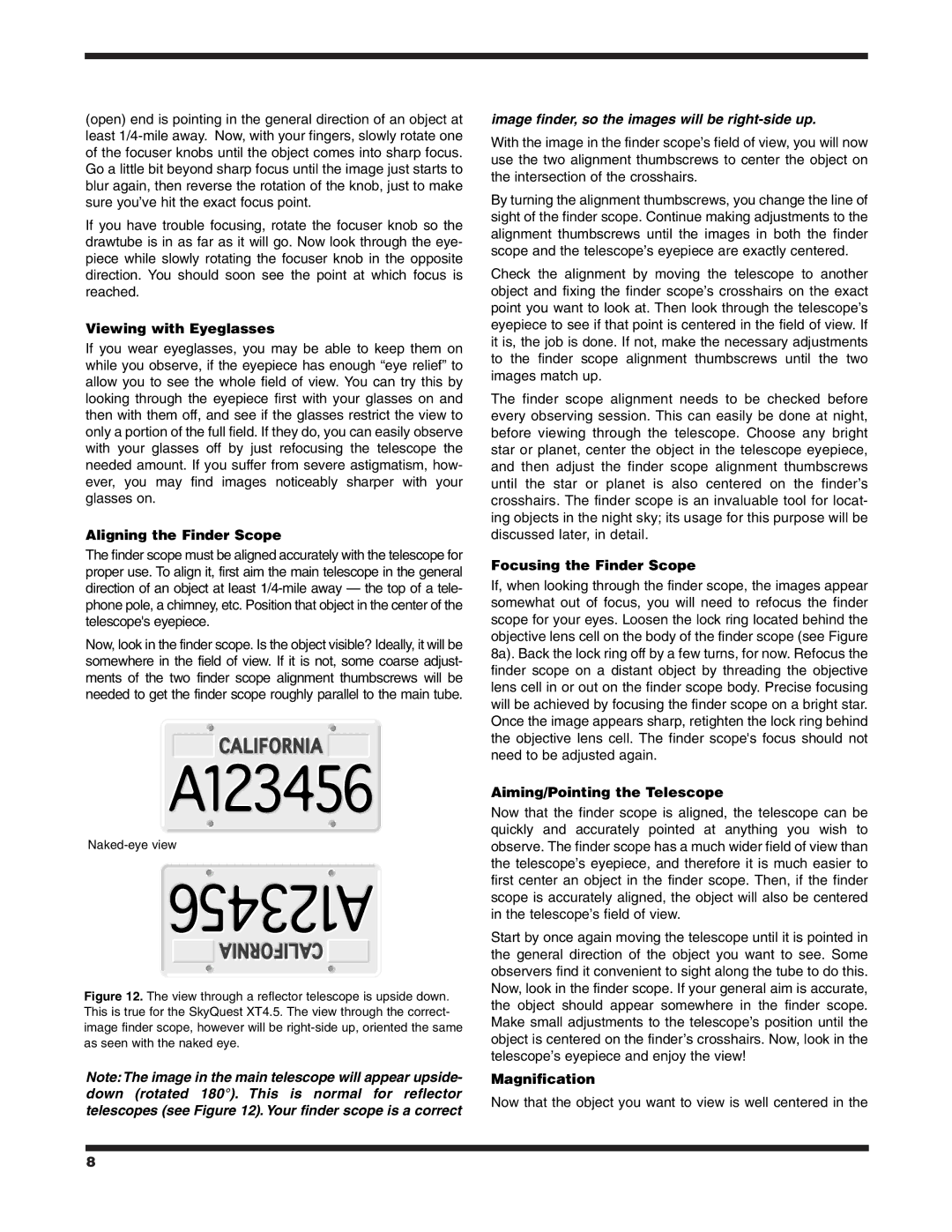
(open) end is pointing in the general direction of an object at least
If you have trouble focusing, rotate the focuser knob so the drawtube is in as far as it will go. Now look through the eye- piece while slowly rotating the focuser knob in the opposite direction. You should soon see the point at which focus is reached.
Viewing with Eyeglasses
If you wear eyeglasses, you may be able to keep them on while you observe, if the eyepiece has enough “eye relief” to allow you to see the whole field of view. You can try this by looking through the eyepiece first with your glasses on and then with them off, and see if the glasses restrict the view to only a portion of the full field. If they do, you can easily observe with your glasses off by just refocusing the telescope the needed amount. If you suffer from severe astigmatism, how- ever, you may find images noticeably sharper with your glasses on.
Aligning the Finder Scope
The finder scope must be aligned accurately with the telescope for proper use. To align it, first aim the main telescope in the general direction of an object at least
Now, look in the finder scope. Is the object visible? Ideally, it will be somewhere in the field of view. If it is not, some coarse adjust- ments of the two finder scope alignment thumbscrews will be needed to get the finder scope roughly parallel to the main tube.
Figure 12. The view through a reflector telescope is upside down. This is true for the SkyQuest XT4.5. The view through the correct- image finder scope, however will be right-side up, oriented the same as seen with the naked eye.
Note:The image in the main telescope will appear upside- down (rotated 180°). This is normal for reflector telescopes (see Figure 12). Your finder scope is a correct
image finder, so the images will be right-side up.
With the image in the finder scope’s field of view, you will now use the two alignment thumbscrews to center the object on the intersection of the crosshairs.
By turning the alignment thumbscrews, you change the line of sight of the finder scope. Continue making adjustments to the alignment thumbscrews until the images in both the finder scope and the telescope’s eyepiece are exactly centered.
Check the alignment by moving the telescope to another object and fixing the finder scope’s crosshairs on the exact point you want to look at. Then look through the telescope’s eyepiece to see if that point is centered in the field of view. If it is, the job is done. If not, make the necessary adjustments to the finder scope alignment thumbscrews until the two images match up.
The finder scope alignment needs to be checked before every observing session. This can easily be done at night, before viewing through the telescope. Choose any bright star or planet, center the object in the telescope eyepiece, and then adjust the finder scope alignment thumbscrews until the star or planet is also centered on the finder’s crosshairs. The finder scope is an invaluable tool for locat- ing objects in the night sky; its usage for this purpose will be discussed later, in detail.
Focusing the Finder Scope
If, when looking through the finder scope, the images appear somewhat out of focus, you will need to refocus the finder scope for your eyes. Loosen the lock ring located behind the objective lens cell on the body of the finder scope (see Figure 8a). Back the lock ring off by a few turns, for now. Refocus the finder scope on a distant object by threading the objective lens cell in or out on the finder scope body. Precise focusing will be achieved by focusing the finder scope on a bright star. Once the image appears sharp, retighten the lock ring behind the objective lens cell. The finder scope's focus should not need to be adjusted again.
Aiming/Pointing the Telescope
Now that the finder scope is aligned, the telescope can be quickly and accurately pointed at anything you wish to observe. The finder scope has a much wider field of view than the telescope’s eyepiece, and therefore it is much easier to first center an object in the finder scope. Then, if the finder scope is accurately aligned, the object will also be centered in the telescope’s field of view.
Start by once again moving the telescope until it is pointed in the general direction of the object you want to see. Some observers find it convenient to sight along the tube to do this. Now, look in the finder scope. If your general aim is accurate, the object should appear somewhere in the finder scope. Make small adjustments to the telescope’s position until the object is centered on the finder’s crosshairs. Now, look in the telescope’s eyepiece and enjoy the view!
Magnification
Now that the object you want to view is well centered in the
8
